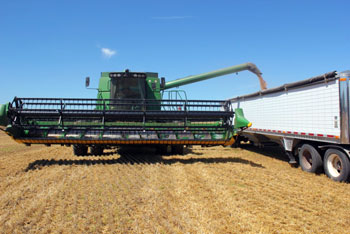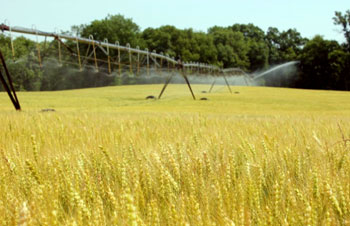Planting second crop soybeans following wheat harvest
Wheat harvest is underway in southwest Michigan, and producers are considering prospects for second crop soybeans.
 Wheat harvest is beginning to get underway across southwest Michigan over the last couple of days. Grain moisture remained high until this week following the period of heavy rainfall over the last two weeks across the region. With bright sunshine, lower humidity and breezy conditions, wheat moisture levels dropped nicely on July 12, 2013. The good news is that irrigated yields have been pretty strong in St. Joseph County. Fields that are slated to produce second crop snap beans and soybeans are being harvested first. Average yields have been running in the low to mid 80 bushels per acre range. The fields I have checked were treated with fungicides and have very little incidence of Fusarium head blight (scab) in the grain.
Wheat harvest is beginning to get underway across southwest Michigan over the last couple of days. Grain moisture remained high until this week following the period of heavy rainfall over the last two weeks across the region. With bright sunshine, lower humidity and breezy conditions, wheat moisture levels dropped nicely on July 12, 2013. The good news is that irrigated yields have been pretty strong in St. Joseph County. Fields that are slated to produce second crop snap beans and soybeans are being harvested first. Average yields have been running in the low to mid 80 bushels per acre range. The fields I have checked were treated with fungicides and have very little incidence of Fusarium head blight (scab) in the grain.
 There are portions of the fields that have yields in the 90 to 100 bushel per acre range. Some areas with lower yields had pockets of lodging. This was especially true in lower areas in the field where water may have stood following heavy thunderstorms that crossed the area. Deer beds – and without a doubt, browse feeding – were also prevalent in the fields were I observed harvest.
There are portions of the fields that have yields in the 90 to 100 bushel per acre range. Some areas with lower yields had pockets of lodging. This was especially true in lower areas in the field where water may have stood following heavy thunderstorms that crossed the area. Deer beds – and without a doubt, browse feeding – were also prevalent in the fields were I observed harvest.
For those contemplating planting second crop soybeans, the clock is ticking rather loudly. Most of the growers I have visited start to become concerned with second crop soybean yield potential when they are planted after July 10. However, with ample moisture in the soil profile and plenty of heat on the horizon, some growers are taking up the challenge and are putting in beans right after the wheat comes off.
 Rick Miller of Villa-Miller Farms near Three Rivers, Mich., shared one important aspect of planting second crop beans following wheat. He indicated that he and his father spent a fair amount of time adjusting the straw flow coming out of the separator to make sure that the distribution of straw out of the chopper was as uniform as possible. They were not waiting around to harvest straw before planting soybeans and snaps, so it is important that the straw does not lay heavier in some areas than others in the wake of the combine. Too much straw can interfere with row cleaners, seed to soil contact, and create differences in soil moisture and temperature and shading when you are planting the beans, even with the heavier 30-inch row planters.
Rick Miller of Villa-Miller Farms near Three Rivers, Mich., shared one important aspect of planting second crop beans following wheat. He indicated that he and his father spent a fair amount of time adjusting the straw flow coming out of the separator to make sure that the distribution of straw out of the chopper was as uniform as possible. They were not waiting around to harvest straw before planting soybeans and snaps, so it is important that the straw does not lay heavier in some areas than others in the wake of the combine. Too much straw can interfere with row cleaners, seed to soil contact, and create differences in soil moisture and temperature and shading when you are planting the beans, even with the heavier 30-inch row planters.
Even with lots of water available in the soil profile now, irrigation plays an important role in the potential success of soybeans following wheat. Drought stress slows down the development of soybean plants. One thing is for sure, we need the plants to grow at their maximum potential to put on soybean size before we reach a killing frost in September or early October.
 Michigan State University Extension is working with Henry and Rick Miller on a project jointly funded by the Michigan Wheat Board and the Michigan Soybean Promotion Committee to investigate the impacts of planting date and soybean maturity group on yield performance in second crop irrigated soybeans. The goal of this research is to determine which maturity groups do the best, especially when planting is delayed.
Michigan State University Extension is working with Henry and Rick Miller on a project jointly funded by the Michigan Wheat Board and the Michigan Soybean Promotion Committee to investigate the impacts of planting date and soybean maturity group on yield performance in second crop irrigated soybeans. The goal of this research is to determine which maturity groups do the best, especially when planting is delayed.



 Print
Print Email
Email

